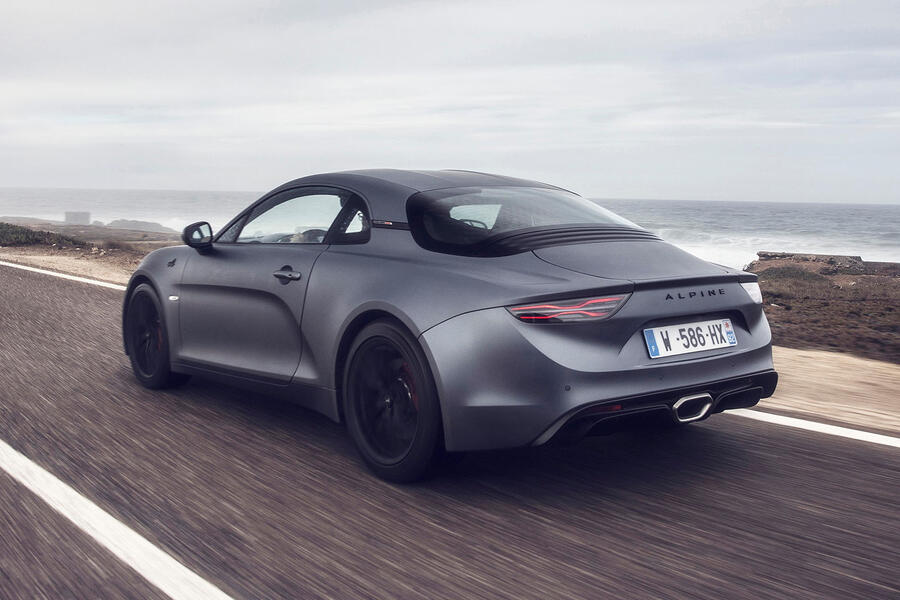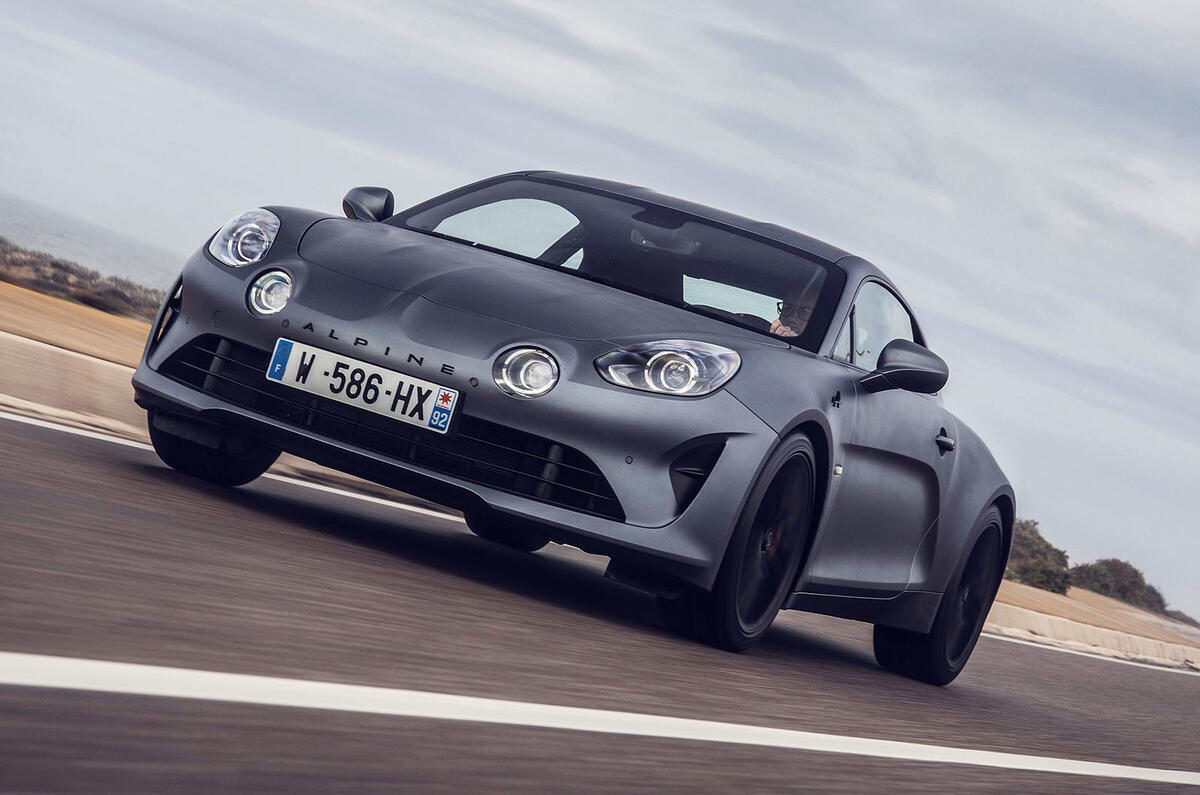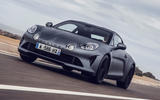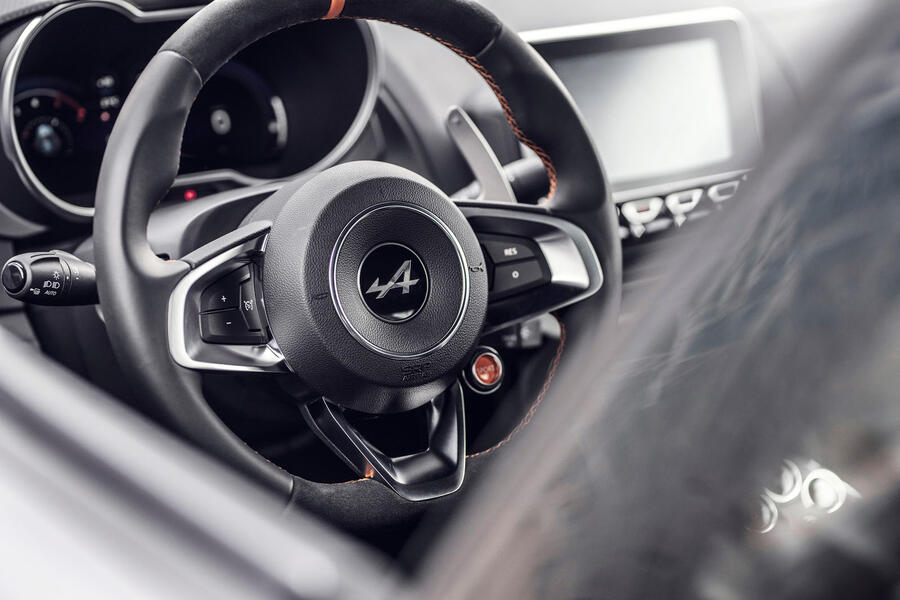What is it?
It's easier to explain what the new Alpine A110 S isn't, actually; and it's not A110 v2.0. Alpine chief vehicle engineer Jean-Pascal Dauce – not so much the new David Twohig as the original, since he worked on the Alpine A110 project in the concept design phase when it was still a joint venture with Caterham and then returned to Renault’s motorsport department only to be brought back when his successor departed – is very clear about that.
“We have had the S planned from the earliest stages of the project,” he explains, “because we knew that a part of the Alpine customer base would want more from the car. More power, more speed, more grip and precision, and better track suitability. It’s as simple as that. We would probably have introduced it earlier if not for the mess that changing emissions laws have made of our business these last 18 months.
"We’re not answering any criticisms of the car with this version, or addressing what we consider to be failings,” he goes on. “Frankly, we don’t think it has too many of those – and the reaction of the market and the media would seem to agree.” To prove his point, he explains that the regular A110 is expected to outsell the new A110 S by about three to one.
If that turns out to be true, it’ll prove yet again how special and unusual this compact, lightweight sports car is – in a segment where so many buyers gravitate by default towards the most powerful and performance-tuned version of the car they’re considering. It’ll prove that most Alpine owners really get the ‘less is more’ philosophy that underpins so much about this car.
And, after a good thrash on both road and track, I’m inclined to agree with what the gut instincts of that majority of buyers may be telling them. For reasons we’ll get to, the A110 S is certainly faster, more precise-handling and more composed at track speeds than the regular A110 – and it can therefore be considered a success at broadening the capability and reach of the car and at complementing the existing model range perfectly well. I’m not sure it’s the one I’d pick, though.



























































Join the debate
Add your comment
I really don't think your
I really don't think your position is consistent/coherent Raven.
You accept that strut suspension is not ideal dynamically- but gives better packaging. I accept that a flat four (or 6 ) engine gives (all things being equal) a lower centre of gravity - but you ignore the downside that you have to sling the gearbox behind to the detriment of polar moment of inertia.
You incorrectly state that puttiing an engine transversely changes the height the engine must be mounted as has been pointed out the sump generally determines the mounting height (and with a dry sump engine the bellhousing on a manual gearbox will provide a similar limit)
So far from the Cayman having technical advantages over the Alpine it's only real net advantage is packaging - hardly a top priority on a sports car.
On the other hand the Alpine has a 300kg weight advantage - without sacrificing anything in refinement or comfort (actually beats the Cayman 981S I last owned.
I would have said that gave the Alpine a major advantage on paper at least.
But as has also been pointed out at the end of the day detailed engineering can overcome some very significant inherent weaknesses as the 911 GT3 shows (it has taken a lot of development to get there!)
“Banging the same drum”
The fact that I’ve been “banging the same drum” for many years is surely a mark of consistency, making a personal comment about me doesn’t answer the question “why do no racing car manufacturers use the rear axle engined transverse set-up”, when just like the production car industry, it would be a “cheap fix” for them ? I’ve enjoyed several transverse rear axle engined cars from Italian, French and English manufacturers over the years, used them all extensively, for me there is no doubt that ultimately, particularly if track driving is your thing, a proper traditional mid engined arrangement is superior, for the road in these congested times it probably doesn’t matter a hoot. For many owners the capacious luggage space the Cayman’s strut suspension allows would totally outweigh the dynamic benefits of the internally space hungry double wishbone arrangement of the Alpine. The failings of strut suspension are well documented and pretty obvious, however I’ve seldom seen them offered by the motoring press as much of a failing in the Cayman. Because in later life I’m lucky enough to spend a lot of time driving around in circles on race tracks, my own Cayman GT4 has multi-link rear suspension, which is probably a rather frivolous conversion, but certainly offers a good bit more grip in long corners and overall better rear wheel control which in turn improves stability under race track style braking. As you clearly a knowledgeable chap, perhaps you can enlighten me with regard to my question ?
Ravon wrote:
I did. Read my post again.
It’s surely about fundamentals ?
School boy physics applied to the Alpine v Cayman argument must surely result in a resounding win for the Cayman , it has a flat ( boxer ) engine, ahead of the rear wheels in the traditional “Mid-engined” configuration, this requires a custome transaxle gearbox/differential. The Alpine has a front wheel drive, drivetrain moved to the rear of the car, which means the engine is located almost upon the rear axle and the engine is high in the chassis . Extending the argument to simple everyday situations for car enthusiasts, name me how many transverse axle engined cars have been successful in competition over the years, and compare with their success of traditional “mid-engined” cars ? Only two come into my elderly mind the first 1.5 litre Honda Grand Prix car which won one only GP ( the Mexican GP , the last race of the 1.5 litre formula in around 1965 ) and the Lancia Stratos Rally Car ? If taking a front drive, drive train and moving it to the rear axle was a satisfactory way to go every manufacturer would be doing it, the only reason to go this route is it’s cheap !
Ravon
Very knowledgable Ravon. Might I add the other problem is Renault stated that in this format the adapted Megane engine can't have a manual box fitted due to space constraints
Ravon wrote:
Just out of interest, when you were researching the orientation of engines in racing cars, did you happen to notice that "proper" racing cars have double wishbone suspension in an attempt to optimise camber control, as opposed to a compromised hatchback style multi link setup like the Cayman? "This must surely be a resounding win for the Lotus/Alpine/Alfa......"
Why on earth would you think it reasonable to pick on one aspect of the architecture of a car in isolation and declare a "resounding success", ignoring other compromises made? You say the transverse engines are mounted higher, but did you also consider that overall the Alpine is a lower, lighter, car, the driver sits lower etc. The only thing that matters at the end of the day is how different parts of the car work together, given the compromises each designer made. I've not often heard people say Lotus for example have the dynamics of their cars all wrong!
Incidentally there is so much interest on this subject that when I googled "transverse engined racing cars" the first thing that popped up was a 5 year old Pistonheads post from yourself banging the same drum!
Ravon wrote:
So lets just pick up on some of this schoolboy physics. You seem to think the more forward engine of the Cayman to be a good thing. Well Ferrari know a thing or two about designing mid engined cars, and the F:R weight distribution of the F8 is 41.5 : 58.5 (Ferrari data). A slight rearward bias. The Cayman 718 is 45:55 (Porsche press release.) The Alpine is 44:56, so similar to the 718, but bettween the two.
Now that "high up in the chassis" engine. What is important is not CoG absolute, but the roll moment (CoG x Mass). As the Alpine is 20% lighter than the Cayman, it could actually accomodate a CoG 20% higher to achieve the same roll moment. It is highly unlikely that this is the case, particularly as I already pointed out that the Alpine is the lower car. I don't have the figures, but I would be willing to bet that the Alpine has the lower roll moment. (And of course it has the advantage of that double wishbone suspension to control camber angle under roll)
So run that "resounding win" by me again.
Ravon wrote:
For somebody who started a post talking about fundamental science, it is amazing how much you got fundamentally wrong. The statement above is simply not true. It just occurred to me on my morning dog walk, that on every transverse engined car I have changed the oil on, the sump is the low point. Rather like a longitudinal engine! I checked a few engine layouts on line, I found a particularly good one of the Evora, and sure enough, gearbox on the back of the engine, with the driveshafts along the back, sump lower than the driveshafts. Turning the engine through 90 degrees doesn't help you get it any lower in the chassis, unless you want to risk losing the sump on a speedbump. So your argument of the past 5 years would seem to be baseless.
When you asked on pistonheads all those years ago why racing cars use longitudinal answers, you were given some valid answers, which you clearly didn't listen to. As a layman, I found a couple of reasons subscribers gave quite compelling: Left-right symmetry is needed if you are going to use the engine + gearbox as a stressed component, and there are clear aero benefits on a single seater if the engine is mounted longitudinally behind the driver. Neither of these benefit your Cayman.
Note however that it is not all one way traffic. Transverse engine/gearbox combos tend to be lighter, and incur less transmission losses by not having to turn the drive through 90 degrees.
Transverse mid engined sports cars are by no means a new pehnomenon. I fondly remember my bedroom poster from my schooldays of the Lamborghini Muira, a transverse mid engined supercar of the time.
School boy physics will tell
School boy physics will tell you that a 911 GT3 should be a truly aweful handling car.
The reason Alpine and Lotus and others go for a transverse 4 is because it is cost effective. - If Alpine are going to spend lots of money on a completely aluminium body and aluminium double wishbone suspension, and a (very expensive) bespoke gear ratio set they can't spend the money on a bespoke engine.
In any case a transverse engine and gearbox, forward of the rear axle will, as schoolboy physics will tell you, give you a lower polar moment of intertia than one with gearbox hanging out of the back.
bcr5784 wrote:
Indeed every way you look at it Physics favours the transverse setup. Less mass, lower transmission losses, and less volume. But we all know building a car is about engineering not physics, and other factors come into play. To me, Cayman and Alpine are both great cars, and we are lucky to have such a choice. What I don't get though, is why Porsche owners repeatedly use negativity to belittle the Alpine - it's not a proper mid engine, its just a Renault, its got a small engine, and even junk science, instead of debating the relative merits after driving both.